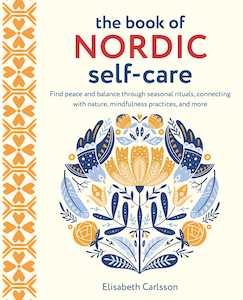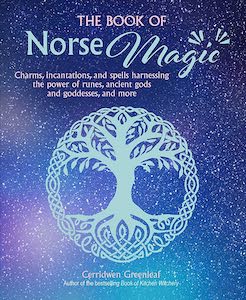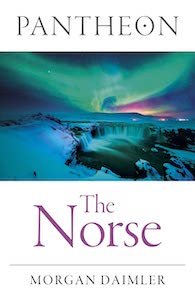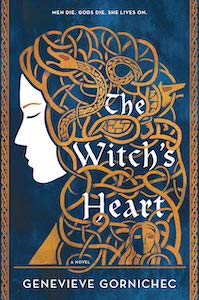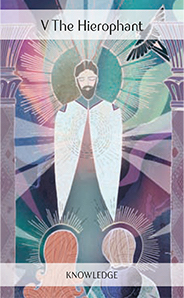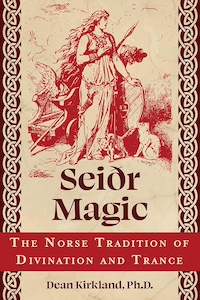
Seiðr Magic: The Norse Tradition of Divination and Trance, by Dean Kirkland, Ph.D.
Destiny Books, 1644119447, 256 pages, April 2024
Seiðr (pronounced “SAY-ther”) is a form of tribal shamanism unique to medieval Norse culture. Since there is very little historical documentation of this ancient practice, it’s not clear exactly what was involved, and in the modern revival of Germanic heathenry, seiðr is often inaccurately glossed over as a type of Norse witchcraft and used as an umbrella term for contemporary witchery, such as spellcasting and reading runes and tarot cards.
In his debut work, Seiðr Magic: The Norse Tradition of Divination and Trance, heathen reconstructionist and woodland conservationist Dean Kirkland, who holds a Ph.D. in ecology, argues that there is indeed enough archeological evidence to revitalize the practice of seiðr, using literature, artifacts, and the unverified personal gnosis of modern practitioners. The primary literary source Kirkland refers to is Eirik the Red’s Saga, which vividly depicts the ritual garb and practice of a völva and prophetess named Thorbjorg (völva means “staff-bearer” and is a female seiðr-worker1). He supplies a pronunciation guide for Old Norse words at the beginning of the book, and a glossary of terms in the back, which makes the foreign terminology easier to comprehend and digest.
By comparing the ancient tools of seiðr-workers to those used by Indigenous shamans, Kirkland believes we can make educated guesses about Norse shamanism based on similarities. He has devoted several years to researching and engaging in shamanic practices, and has studied Andean shamanism with an indigenous paco. He currently resides in Lincolnshire, UK, where he is dedicated to woodland conservation and restoration.
Since seiðr was considered a form of magic, it was not a common practice among Norse heathens. Seiðr-workers were viewed with suspicion by the general populace and lived on the fringes of society. Contrary to modern neo-pagan faiths like Wicca, which integrates witchcraft with religious rites, there was a social stigma surrounding practicing magic among ancient heathens. Perhaps with good reason, because Kirkland warns that seiðr can be perilous for both the practitioner and their community, since it involves contact with mighty and potentially very dangerous wights, or spirits. However, he assures readers that the introductory exercises presented in this book are designed to make the practice as safe as possible for beginners. That being said, seiðr is not for everyone; it is a shamanic path of service to both the spirits and humanity as a whole, destined for a chosen few.
“Seiðr-workers are chosen by Wyrd, which is to say fate or destiny, and made by the gods,”2 Kirkland says.
Seiðr-workers are mediums for wights, the spiritual beings they serve, and the greater community at large. The wights that are friendly towards humans are interested in collective spiritual growth and advancement, not individual progress. According to Kirkland, “the effect of shamanic work must be shared with others—if you focus solely on yourself and your own spiritual development, you are coming at this from an ego-based approach, and ego is the implacable enemy of all shamans.”3
Attempting to practice seiðr for selfish gain and to satisfy an egoic craving for increased personal power is disrespectful to the wights and may incur their wrath. Furthermore, one should not assume the role of seiðr-worker unless they are recognized as such by the community. “Titles should never be taken for oneself, but only bestowed by others,”4 Kirkland says. He sees community validation as a sign of authenticity. I found this to be an interesting perspective, because this line of thinking could be used to insinuate that an accused witch, whether they personally identify as one or not, is serving that role for the community because it has been projected upon them.
Kirkland dispels the common misconception that only women and homosexual men can practice seiðr, and provides historical context as to why it has been perceived as a feminine art. In the warrior dominated society of the Vikings, covertly practicing magic on the battlefield instead of confronting an opponent directly would have been viewed as cowardly. The shamanic practice of channeling spirits was also seen as an intimate form of receptivity comparable to sexual penetration. Kirkland argues that, despite these stereotypes, straight men are just as capable of practicing seiðr as a woman or a gay man. It is the spiritual calling to do so that matters, not one’s sexual orientation or gender identity.
Kirkland clarifies the role of fate in relation to seiðr and I was intrigued by his discussion of hamingja in particular. Hamingja is often simplified as the Norse version of luck, and Kirkland explains that everyone has a limited amount of hamingja allotted to them by the Norns at birth. For those who believe in reincarnation, he suggests that this allotment may be higher for new souls who have less experience in the physical realm, so they can have an easier time adjusting to the material plane, whereas old souls are presented with more challenges in life in order to facilitate spiritual growth. Seiðr-workers would therefore have very little hamingja, forcing them to rely on their supernatural relationships with the wights to get them through life instead of materialism. This makes sense to me, because shamans tend to be initiated by traumatic experiences, which detach their spirits from their physical bodies so they can traverse the unseen realms during trance and communicate with the entities that reside there.
Hamingja is closely intertwined with megin, which means “might” or “honor,”5 and is accrued through doing good deeds for living beings and wights and keeping one’s promises to them, which builds trust with the spirit realm. Helping the Norns apply clay to the roots of the World Tree Yggdrasil during shamanic trance is given as an example of a way to build megin.
Kirkland details the ritual clothing (referred to endearingly as “shaman’s armor”) and the shamanic tools unique to seiðr-workers, the most important one being a seiðstafr, or “seiðr-staff,” which, instead of a drum, is rhythmically tapped to induce a trance.6 Archaeologists have found staves of this nature in the graves of seiðr-workers. Most of them were wooden, but iron ones have also been discovered, buried with an elite few. Kirkland provides instructions on how to obtain, craft, and awaken one’s own sacred seiðstafr. He also includes photos of his personal staff for reference.
The seiðstafr reminds me of the stang, or forked staff, of traditional witchcraft, which serves as an axis mundi, or World Tree, for traversing the shamanic realms. During trance work, Kirkland emphasizes the importance of having some sort of focal point that exists in the physical plane and functions as an axis mundi, to serve as a gateway through which one can enter and leave the spirit realm. He warns that not having this anchor to the physical world can cause parts of the soul to get lost during shamanic journeys.
Understanding the various components of the soul is a crucial part of practicing seiðr, since it includes spiritual healing techniques that involve the extraction of energetic blockages and the retrieval and reintegration of lost soul parts. Kirkland explains that the Germanic soul complex is composed of four major parts: the lík, or lich, which encompasses the physical body, and is animated by the önd, the “sacred breath”7 of life, bestowed by the Allfather Óðinn; the hamr, meaning “shape” or “skin,”8 which is the etheric body that takes flight during shamanic journeys, and has the ability to shift shape; the fylgja, or “follower,”9 which can take the form of an animal and acts as a psychopomp upon death; and the hugr, or “mind,”10 which continues on in the afterlife.
For protection during rituals and shamanic travels, Kirkland considers casting a magic circle to be ineffective, since the circle is physically present in a fixed location while the shaman’s spirit wanders. The primary means of protection is merging with a spirit ally, in a type of “low-level” possession, in which the practitioner remains in complete control. Seiðr-workers use magical chants called varðlokur, meaning “ward songs” or “guardian songs,”11 to summon spirits and raise protective energies. Coupled with the rhythmic beating of the seiðr staff, these cantillations induce shamanic trance. Kirkland does not provide any of these chants because there are no surviving authentic examples. Besides, the most powerful ones are given to the seiðr-worker by the wights themselves, and he offers shamanic techniques for acquiring them, including a ritual invocation using lyrics from a modern song by the Norwegian folk band Wardruna, which is brilliant, since anyone can listen to the song for the correct pronunciation of the words. In addition, he suggests using galdr, or runic chanting, to raise vibrations, and recommends intoning the runes laguz and algiz to spiritually clear the air. He also supports the use of mugwort as a purification incense, as opposed to the more popular white sage, which is not native to Germanic lands.
This book has been so illuminating for me because it explains the reasoning behind some shamanic practices that I have intuitively discovered through trial and error on my own. I abandoned circle casting several years ago, and I appreciated Kirkland’s explanation of why circles are ineffective for self-protection, because I couldn’t articulate why I stopped; I just felt that I didn’t need to cast them anymore. Now I purify my sacred space with incense and use deity epithets like ward songs.
I once had a dream in which a hag spirit merged with me. She told me telepathically that she enters my body and sees through my eyes to help me. It wasn’t creepy, or anything at all like a horror movie possession. It felt more like being in the driver’s seat of a car and having a guardian spirit riding shotgun. She was observing through the windshield of my eyes and whispering in my mind, but not interfering or controlling my actions. I’m not sure who she is, but I know she is some sort of guardian spirit and she has appeared to me in multiple dreams as a witchy old woman with long silver hair. She felt so familiar she could be an ancestor or an elderly version of myself, and I’ve felt blessed by every interaction with her.
I’ve always sensed that I have mediumship abilities, but fear of possession has been a barrier to developing them further, and that dream made me realize that merging isn’t invasive and makes spirit communication easier. Learning from Seiðr Magic that wights merge with seiðr-workers really clarified the significance of this dream for me. I identify as a witch, and I don’t feel a calling to be a seiðr-worker, but traditional witchcraft is heavily influenced by Norse practices, and shamanism is universal, so I’m seeing a lot of overlap between both traditions.
An important class of wights Kirkland writes about is the dísir, or lesser Norns. The dísir are female ancestral spirits that watch over and guide their descendants. According to Kirkland, it’s possible to have a nonhuman dís/lesser Norn. He claims to have met people who have lesser Norns that are elves, dwarves, and even giants! I now suspect that my hag spirit might be my lesser Norn.
Kirkland also discusses the often overlooked wights of place, such as landvættir, or land spirits, and the cofgodas (pronounced “COAF-goadas”), or “household gods,”12 which are the spirits of hearth and home. Although working with these entities falls under the domain of “folk conjuring”13 or trolldómr (“witchcraft”), he believes land spirits and house wights should be part of general heathen practice. He gives instructions on how to communicate with local wights, as well as how to detect whether or not you have cofgodas living in your home, and if not, how to attract them and create a hearth altar and a spirit house for them.
The multiverse has always been my favorite feature of Norse cosmology, and I was captivated by Kirkland’s detailed exploration of the nine realms on the cosmic World Tree of Yggdrasil. For shamanic journeying, the fiery hellscape of Muspelheim and the icy wastelands of Niflheim are no doubt the least hospitable, but I was surprised to learn that one of the most dangerous realms to traverse in spirit is Midgard, our physical realm. Kirkland claims that this is because Midgard is the crossroads of the nine realms, and entities that do not belong here in Middle Earth sometimes get trapped and lash out at humans. The World Serpent Jörmungandr is the guardian of Midgard, and keeps many entities out, but earthbound spirits may stay trapped within. Kirkland therefore recommends that beginners avoid traversing the middle realms in spirit, which also include Ljósálfheim, the domain of the light elves, and Svartálfheim, the realm of dwarves and dark elves, until they have gained more shamanic experience.
While it may be dangerous for beginners, guiding earthbound spirits out of Midgard is part of the job description of a seiðr-worker, and Kirkland gives detailed guidance on how to handle the dead. “Unfinished business” is the stereotypical reason why ghosts are believed to linger, and I was surprised that Kirkland says this is “relatively rare,” since it requires a lot of willpower on the part of the deceased.14 More common reasons for a spirit remaining in Midgard are confusion about being dead or addiction to substances only found here in Middle Earth, requiring the hungry ghost to attempt temporary possession of the living in order to get their fix. In haunted pubs, for example, restless spirits may lurk in bathrooms, waiting to hitch rides with drunks relieving themselves in the stalls, which is a creepy thought, especially if one is prone to blackouts. It definitely makes one think twice about engaging in mind-altering substance abuse, for the sake of spiritual hygiene. While entheogens have their place in shamanism, Kirkland does not suggest using them to achieve shamanic states.
Western society’s denial of death and Christianity’s suppression of spirit workers has exacerbated the problem of earthbound spirits. Since there are few spirit workers, Kirkland warns readers that Midgard is overpopulated with wandering ghosts, and practitioners will be in high demand for the role of psychopomp, guiding trapped spirits to their proper afterlife destination. He gives instructions on how to do so with the assistance of a valkyrie, a female psychopomp who works for Óðinn. In the rare case that a seiðr-worker comes across a draugr (a restless spirit attached to a corpse, which is the Nordic equivalent of a zombie), there are instructions for dealing with that problem as well.
Seiðr Magic is a wonderful blend of rigorous scholarship and creative heathen reconstruction. Kirkland’s lucid, honest prose always clarifies which practices are based on historical evidence and which insights have come from the unverified personal gnosis of modern practitioners. This book is a boon for those looking to recreate a traditional Norse magical practice that is as authentic as possible given the archaeological evidence currently available to us. Whether one feels a calling to practice seiðr or not, this is a fascinating read for anyone interested in Norse shamanism, spirit work, and heathen spirituality.

Rachel Christina McConnell is a witch, tarot reader, intuitive astrologer, and writing spider. She holds an MFA in Fiction from Columbia University in the City of New York. Her short stories have appeared in Dark Moon Lilith Press and Minerva Rising Press’s The Keeping Room. Links to her publications are available here: https://rachelchristinamcconnell.wordpress.com


